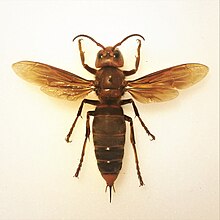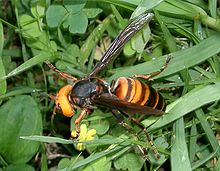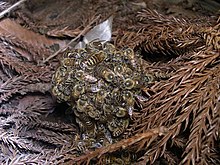SCI-TECH : ASIA’s ‘Vespa Mandarinia’ to attack the U.S.?
ASIA’S ‘MURDEROUS’ HORNETS MIGRATE TO US:
.

Hundreds of Asian giant hornets – an invasive, predatory insect – have been found in Washington state, where they pose a threat to humans and the beekeeping industry.
.
The stinging Vespa mandarinia, which is native to Southeast Asia, China and Taiwan, kills up to 50 people a year in Japan.
.
.
TRIVIA:
Asian giant hornet
| Asian giant hornet | |
|---|---|
 |
|
| Vespa mandarinia magnifica. Private collection, F. Turetta. | |
| Scientific classification |
|
| Kingdom: | Animalia |
| Phylum: | Arthropoda |
| Class: | Insecta |
| Order: | Hymenoptera |
| Family: | Vespidae |
| Genus: | Vespa |
| Species: |
V. mandarinia
|
| Binomial name | |
| Vespa mandarinia | |
| Synonyms | |
| Vespa japonica Radoszkowski, 1857 Vespa bellona Smith, 1871 Vespa magnifica var. latilineata Cameron, 1903 Vespa mandarina Dalla Torre, 1894 (misspelling) Vespa magnifica sonani Matsumura, 1930 |
|
.
The Asian giant hornet (Vespa mandarinia), including the former subspecies referred to as the “Japanese giant hornet”[2] is the world’s largest hornet. It is native to temperate and tropical East Asia, South Asia, Mainland Southeast Asia, and parts of the Russian Far East. It was also found in the Pacific Northwest of North America in late 2019, with no reports since to suggest that they have become established there. They prefer to live in low mountains and forests, while almost completely avoiding plains and high-altitude climates. Vespa mandarinia creates nests by digging, co-opting pre-existing tunnels dug by rodents, or occupying spaces near rotted pine roots.[3] It feeds primarily on larger insects, colonies of other eusocial insects, tree sap, and honey from honey bee colonies.[4] The hornet has a body length of 45 mm (1.8 in), a wingspan around 75 mm (3.0 in), and a stinger 6 mm (0.24 in) long, which injects a large amount of potent venom.[5]
The Asian giant hornet is often confused with the yellow-legged hornet (Vespa velutina), also known as the Asian hornet, an invasive species of major concern across Europe, including the UK.
Taxonomy and phylogeny
Vespa mandarinia is a species in the genus Vespa, which comprises all true hornets. Along with seven other species, V. mandarinia is a part of the V. tropica species group, defined by the single notch located on the apical margin of the seventh gastral sternum of the male. The most closely related species within the species group is V. soror. The triangular shape of the apical margin of the clypeus of the female is diagnostic, the vertex of both species is enlarged, and the shape of the apex of the aedeagus is distinct and similar.[6] Division of the genus into subgenera has been attempted in the past,[7] but has been abandoned, due to the anatomical similarity among species and because behavioural similarity is not associated with phylogeny.[3] As of 2012, there are only three subspecies recognized:[8] V. m. mandarinia Smith, 1852 (Eastern China, Korea, Russia, and Japan); V. mandarinia magnifica Smith, 1852 (Western China, India, Nepal, Myanmar, Laos, and peninsular Malaysia); V. mandarinia nobilis Sonan, 1929 (Taiwan only). The former subspecies referred to as V. mandarinia japonica has not been considered valid since 1997.[9]
.
Description
Regardless of sex, the hornet’s head is a light shade of orange and its antennae are brown with a yellow-orange base. Its eyes and ocelli are dark brown to black. Vespa mandarinia is distinguished from other hornets by its pronounced clypeus and large genae. Its orange mandible contains a black tooth that it uses for digging.[10] The thorax is dark brown, with two grey wings varying in span from 3.5 to 7.5 cm. Its forelegs are brighter than the mid and hind legs. The base of the forelegs is darker than the rest. The abdomen alternates between bands of dark brown or black and a yellow-orange hue (consistent with its head color). The sixth segment is yellow. Its stinger is typically 6 mm long and contains a potent venom that, in cases of multiple hornets stinging simultaneously, can kill a human.[10]
Queens and workers
The queens are considerably larger than workers. Queens can exceed 50 mm (2.0 in), while workers are between 35 and 40 mm (1.4 and 1.6 in). The reproductive anatomy is consistent between the two, but workers do not reproduce.[10]
.
Drones
Drones (males) are similar to females, but lack a stinger. This is a consistent feature among Hymenoptera.[10]
Geographic distribution
The hornet can be found in the Primorsky Krai, Khabarovsky Krai (southern part only) and Jewish AO regions of Russia, Korea (where it is called 장수말벌 “general officer hornet”), China, Taiwan (simplified Chinese: 虎头蜂; traditional Chinese: 虎頭蜂; literally: ‘tiger head bee’), Laos, Thailand, Cambodia, Myanmar, Vietnam, Nepal, India and Sri Lanka, and common in Japan, where it prefers rural areas where it can find trees to nest in[2] and is known as the ōsuzumebachi (オオスズメバチ(大雀蜂、大胡蜂), literally, “great sparrow bee”). At least by 2008, some popular media outlets in Japan also referred to this wasp as “satsujin suzumebachi” (殺人スズメバチ, literally, “murder hornet”)[11], a name that was passed along in 2020 to a New York Times reporter.[12]
In September 2019, the British Columbia Ministry of Agriculture confirmed that hornets were found on Vancouver Island in Canada, with a nest having been discovered and subsequently destroyed in the city of Nanaimo.[13][14] In December 2019, the Washington State Department of Agriculture confirmed a reported sighting, as well as a dead specimen in Blaine, Washington on the U.S. side of the border adjacent to Vancouver Island, the first report of this species in the United States, and very close to the September sightings.[15] In April 2020, authorities in Washington asked members of the public to be alert and report any sightings of these wasps, which are expected to become active in April if they are in the area.[16] If they become established, it is claimed that the hornets “could decimate bee populations in the United States and establish such a deep presence that all hope for eradication could be lost.” A “full-scale hunt” for the species by the Washington State Department of Agriculture is underway.[12] Laboratory findings determined that the specimens collected from British Columbia and Washington State were from different colonies, thus suggesting that there were two simultaneous introductions of the Asian giant hornet to North America within approximately 50 miles of one another.[12]
Reports of this species from other parts of the world are erroneous identifications of other hornet species, such as V. orientalis and V. velutina in Europe.[17]
.
Nesting
Vespa mandarinia nests in low mountain foothills and lowland forests. As a particularly dominant species, no efforts are directed toward conserving V. mandarinia or its habitats, as they are common in areas of low human disturbance. Unlike other species of Vespa, V. mandarinia almost exclusively inhabits subterranean nests. In a study of 31 nests, 25 were found around rotten pine roots. Additionally, rodents, snakes, or other burrowing animals previously made some of the tunnels. The depth of these nests was between 6 and 60 cm. The entrance at the ground surface varies in length from 2 to 60 cm either horizontally, inclined, or vertically. The queens that found the nest prefer narrow cavities.[18]
Nests of Vespa typically lack a developed envelope. During the initial stages of development, the envelope is in an inverted-bowl shape. As the nest develops, one to three rough sheets of combs are created. Often, single primordial combs are created simultaneously and then fused into a single comb.[18]
A system of one main pillar and secondary pillars connects the combs. Nests usually have four to seven combs. The top comb is abandoned after summer and left to rot. The largest comb is at the middle to bottom portion of the nest. The largest combs created by Vespa measured 49.5 cm by 45.5 cm with 1,192 cells (no obstacles, circular) and 61.0 cm by 48.0 cm (elliptical; wrapped around root system).[18] In some Japanese mountain villages, the nests are excavated and the larvae are considered a delicacy when fried.[2]
Colony cycle
The nesting cycle of V. mandarinia is fairly consistent with that of other eusocial insects. Six phases occur in each cycle.[18]
.
Prenesting period
Inseminated and uninseminated queens enter hibernation following a cycle. They first appear in early to mid-April and begin feeding on the sap of Quercus trees. Although this timing is consistent among hornets, V. mandarinia dominates the order, receiving preference for premium sap sources. Among the V. mandarinia queens is a dominance hierarchy. Top-ranked queens begin feeding, while the other queens form a circle around her. Once the top queen finishes, the second-highest ranking queen feeds. This process repeats until the last queen feeds at a poor hour.[18]
.
Solitary, cooperative and polyethic periods
Inseminated queens start to search for nesting sites in late April. The uninseminated queens do not search for nests since their ovaries never fully develop. They continue to feed, but then disappear in early July.
An inseminated queen begins to create relatively small cells in which she raises around 40 small workers. Workers do not begin to work outside of the hive until July. Queens participate in activities outside the hive until mid-July when they stay inside the nest and allow workers to do extranidal activities. Early August marks a fully developed nest, containing three combs holding 500 cells and 100 workers. After mid-September, no more eggs are laid and the focus shifts to caring for larvae. The queens die in late October.[18]
Dissolution and hibernating period
Males and new queens take on their responsibilities in mid-September and mid-October, respectively. During this time, their body color becomes intense and the weight of the queen increases about 20%. Once the males and queen leave the nest, they do not return. In V. mandarinia, males wait outside the nest entrance until the queen emerges. Once the queen emerges, they intercept her midair, bring her to the ground, and copulate from 8 to 45 seconds. After this episode, the males return to the entrance for a second chance, while the queen leaves. Many queens attempt to fight off the males and leave unfertilized. After this episode, queens are found in moist, subterranean habitats.
When sexed individuals emerge, workers shift their focus from protein and animal foods to carbohydrates. The last sexed individuals to emerge die of starvation.[18]
.
Sting
The stinger of the Asian giant hornet is about 6 mm (0.24 in) long,[5] and injects an especially potent venom that contains, like many bee and wasp venoms, a cytolytic peptide (specifically, a mastoparan) that can damage tissue by stimulating phospholipase action, in addition to its own phospholipase.[18] The stinger of the Asian giant hornet is about 4.5 mm (0.18 in) longer than a traditional honeybee.[19] Masato Ono, an entomologist at Tamagawa University near Tokyo, described the sensation as feeling “like a hot nail being driven into my leg”.[5]
The venom contains a neurotoxin called mandaratoxin,[18] a single-chain polypeptide with a molecular weight around 20 kD.[18] While a single wasp cannot inject a lethal dose, it can be lethal even to people who are not allergic if the dose is sufficient (i.e., if multiple stings are received). However, if the victim is allergic to the venom, this greatly increases the risk of death. Tests involving mice found that the venom falls short of being the most lethal of wasp venom, having an LD50 of 4.0 mg/kg. In comparison, the deadliest wasp venom (at least to lab mice) by weight belongs to Vespa luctuosa at 1.6 mg/kg. The potency of the sting is due, rather, to the relatively large amount of venom injected.[20]
.
Effects of stings on humans
Since 2001, the yearly human death toll caused by stings of bees, wasps and hornets in Japan has been ranging between 12 and 26.[21] Since this number also includes deaths caused by wasps, bees and other hornet species, the number of deaths caused by Asian giant hornets is likely significantly lower.
Advice in China is that people stung more than 10 times need medical help, and need emergency treatment for more than 30 stings. The stings can cause kidney failure.[22] In 2013, stings by Asian giant hornets killed 41 people and injured more than 1,600 people in Shaanxi, China.[23]
Fatalities from envenomation are primarily related to anaphylactic shock or cardiac arrest. Deaths have occurred as a result of multiple organ failure, typically after a large number of stings.
All sting victims exhibited signs of skin hemorrhaging and necrosis, though both are otherwise rare.[clarification needed] The two likely reasons for skin hemorrhaging and necrosis are an inability to effectively neutralize the venom, or unusually potent venom toxicity for that set of stings. In either case, these stings lead to multiple organ injury. While not everyone displayed lesions or necrosis, a strong correlation existed between the number of stings and the severity of injury. Those who died, on average, were stung 59 times (with a standard deviation of 12), while those who survived suffered 28 stings (with a standard deviation of 4).[24]
.
Parasites
Xenos moutoni is a common parasite among Vespa species. In a study of parasites among species of Vespa, 4.3% of V. mandarinia females were parasitized. Males were not stylopized (parasitized by Stylopidae, such as Xenos moutoni) at all. The width of the stylopid’s head and the host’s head are positively correlated. The major consequence of being parasitized is the inability to reproduce for the following year. Stylopized queens follow the same fate as uninseminated queens. They do not search for an area to create a new colony and feed on sap until early July, when they disappear. In other species of Vespa, males also have a chance of being stylopized. The consequences between the two sexes are similar, as neither sex is able to reproduce.[25]
.
Communication and perception
V. mandarinia uses both visual and chemical cues as a means of navigating itself and others to the desired location. Scent marking was discussed as a way for hornets to direct other members of the colony to a food source. Even with antennae damage, V. mandarinia was able to navigate itself. It was unable to find its destination only when vision impairment was induced. This implies that while chemical signaling is important, visual cues play an equally important role in guiding individuals. Other behaviors include the formation of a “royal court” consisting of workers that lick and bite the queen, thereby ingesting her pheromones.
These pheromones could directly communicate between the queen and her court or indirectly between her court and other workers due to the ingested pheromones. This is merely speculation, as no direct evidence has been collected to suggest the latter. Vespa mandarinia communicates acoustically, as well. When larvae are hungry, they scrape their mandibles against the walls of the cell. Furthermore, adult hornets click their mandibles as a warning to other creatures that encroach upon their territory.[10][26]
.
Scent marking
Vespa mandarinia is the only species of social wasp known to apply a scent to direct its colony to a food source. The wasp secretes the chemical from the sixth sternal gland, also known as van der Vecht’s gland. This behavior is observed during autumnal raids after the hornets begin hunting in groups instead of individually. The ability to apply scents may have arisen because the wasp relies heavily on honeybee colonies as its main food source. A single wasp is unable to take on an entire colony of bees because species such as Apis cerana have a well-organized defense mechanism. Honeybees swarm one wasp and flutter their wings to heat up the wasp and raise carbon dioxide to a lethal level. So, organized attacks are much more effective and easily devastate a colony of tens of thousands of honeybees.[27]
.
Interspecies dominance
In an experiment observing four different species of Vespa, including V. ducalis, V. crabro, V. analis, and V. mandarinia, V. mandarinia was the dominant species. Multiple parameters were set to determine this. The first set parameter observed interaction-mediated departures, which are defined as scenarios wherein one species leaves its position due to the arrival of a more dominant individual. The proportion of interaction-mediated departures was the lowest for V. mandarinia. Another measured parameter was attempted patch entry. Over the observed time, conspecifics (interactions with the same species) resulted in refused entry far more than heterospecifics (interactions with different species). Lastly, fights between these hornets, Pseudotorynorrhina japonica, Neope goschkevitschii, and Lethe sicelis were observed, and once more V. mandarinia was the most dominant species. In 57 separate fights, one loss was observed to Neope goschkevitschii, giving V. mandarinia a win rate of 98.3%. Based on interaction-mediated departures, attempted patch entry, and interspecific fights, V. mandarinia is the most dominant species.[28]
.
Predation
An Asian giant hornet feeding on a mantis
The Asian giant hornet is intensely predatory; it hunts medium- to large-sized insects, such as bees, other hornet species and mantises. The latter are favored targets in late summer and fall. Large insects like mantises are key protein sources to feed queen and drone larvae. Workers forage to feed their larvae, and since the prey can including crop pests, the hornets are sometimes regarded as beneficial. This hornet often attacks both colonies of other Vespa species (Vespa simillima being the usual prey species) and honey bee hives to obtain the adults, pupae and larvae as food for their own larvae; sometimes they also cannibalize each other’s colonies. A single scout, sometimes two or three, cautiously approaches the hive, producing pheromones to lead its nest-mates to the hive. The hornets can devastate a colony of honey bees, especially if it is the introduced western honey bee; a single hornet can kill as many as 40 bees per minute due to its large mandibles, which can quickly strike and decapitate prey. The honey bees’ stings are ineffective because the hornets are five times their size and heavily armored. Only a few hornets (under 50) can exterminate a colony of tens of thousands of bees in a few hours. The hornets can fly up to 100 km (60 mi) in a single day, at speeds up to 40 km/h (25 mph)[29]
Hornet larvae, but not adults, can digest solid protein; the adult hornets can only drink the juices of their victims, and they chew their prey into a paste to feed to their larvae. The workers dismember the bodies of their prey to return only the most nutrient-rich body parts, such as flight muscles, to the nest.[2] Larvae of predatory social vespids generally (not just Vespa) secrete a clear liquid, sometimes referred to as Vespa amino acid mixture, the exact amino acid composition of which varies considerably from species to species, and which they produce to feed the adults on demand.[30]
.
Native honey bees
A defensive ball of Japanese honey bees (Apis cerana japonica) in which two hornets (Vespa simillima xanthoptera) are engulfed, incapacitated, heated and eventually killed: this sort of defense is also used against the Asian giant hornet.
Beekeepers in Japan attempted to introduce western honey bees (Apis mellifera) for the sake of their high productivity. European honey bees have no innate defense against the hornets, which can rapidly destroy their colonies.[2] Although a handful of Asian giant hornets can easily defeat the uncoordinated defenses of a European honey bee colony, the Japanese honey bee (Apis cerana japonica) has an effective strategy. When a hornet scout locates and approaches a Japanese honey bee hive, she emits specific pheromonal hunting signals. When the Japanese honey bees detect these pheromones, a hundred or so gather near the entrance of the nest and set up a trap, keeping the entrance open. This permits the hornet to enter the hive. As the hornet enters, a mob of hundreds of bees surrounds it in a ball, completely covering it and preventing it from reacting effectively. The bees violently vibrate their flight muscles in much the same way as they do to heat the hive in cold conditions. This raises the temperature in the ball to the critical temperature of 46 °C (115 °F). In addition, the exertions of the honeybees raise the level of carbon dioxide (CO2) in the ball. At that concentration of CO2, they can tolerate up to 50 °C (122 °F), but the hornet cannot survive the combination of high temperature and high carbon dioxide level.[31][32] Some bees do die along with the intruder, much as happens when they attack other intruders with their stings, but by killing the hornet scout, they prevent it from summoning reinforcements that would wipe out the entire colony.[33]
Detailed research suggests this account of the behavior of the bees and a few species of hornets is incomplete and the bees and the predators are developing strategies to avoid expensive and mutually unprofitable conflict. Instead, when bees detect scouting hornets, they transmit an “I see you” signal that commonly warns off the predator.[34] Another defence utilized by Apis cerana is speeding up dramatically when returning to the colony, in order to avoid midair attacks.
.
Extermination methods
As of 1973, six different methods were used to control hornets in Japan. Though these methods decrease damage done by V. mandarinia, controlling them entirely is difficult.
.
Beating
Hornets are crushed with wooden sticks with flat heads. Hornets do not counterattack when they are in the bee-hunting phase or the hive-attack phase (“slaughter”), but they aggressively guard a beehive once they kill the defenders and occupy it. The biggest expenditure in this method is time, as the process is inefficient.[18]
.
Nest removal
Applying poisons or fires at night is an effective way of exterminating a colony. The most difficult part about this tactic is finding the subterranean nests. The most common method of discovering nests is giving a piece of frog or fish meat attached to a cotton ball to a wasp and following it back to its nest. With V. mandarinia, this is particularly difficult considering its common home flight radius of 1–2 km. V. mandarinia travels up to 8 km away from the nest.[18]
.
Bait traps
Bait traps are placed in apiaries. The system consists of multiple compartments that direct the hornet into a one-sided hole which is difficult to return through once it is in the cul-de-sac compartment, an area located at the top of the box which bees can escape from through a mesh opening, but wasps cannot due to their large size. Baits used to attract the hornets include a diluted millet jelly solution, crude sugar solution with a mixture of intoxicants, vinegar, or fruit essence.[18]
Mass poisoning
Hornets at the apiary are captured and fed a sugar solution or bee that has been poisoned with malathion. The toxin is expected to spread through trophallaxis. This method is good in principle, but has not been tested extensively.[18]
.
Trapping at hive entrances
The trap is attached to the front of beehives. The effectiveness of the trap is determined by its ability to capture hornets while allowing bees to escape easily. The hornet enters the trap and catches a bee. When it tries to fly back through the entrance of the hive, it hits the front of the trap. The hornet flies upwards to escape and enters the capture chamber, where the hornets are left to die. Some hornets find a way to escape the trap through the front, so these traps can be very inefficient. [18]
.
Protective screens
As explained in the trapping section, if met by resistance, hornets lose the urge to attack and instead retreat. Different measures of resistance include weeds, wire, or fishing nets or limiting the passage size so only bees can make it through. Experienced hornets catch on and eventually stay on these traps, awaiting the arrival of bees. The best method of controlling hornets is to combine these protective screens with traps.[18]
.
Use as a nutritional supplement
Vespa amino acid mixture is a nutritional supplement consisting of larval saliva sold with the intent of improving endurance during exercise. Several companies in Asia and Europe have begun to manufacture dietary supplements and energy drinks which contain synthetic versions of secretions of the larvae of V. mandarinia, which the adult hornets usually consume. The manufacturers of these products make claims that consuming the larval hornet secretions (marketed as “hornet juice”) will enhance human endurance because of the effect it has on adult hornets’ performance. During laboratory testing on mice, increased lipolysis (metabolism of fat) was observed in rat adipocytes (fat cells) alongside improved swimming endurance, decreased lactate, and increased glucose concentration in the bloodstream. While testing on mice has produced optimistic outcomes, trial tests on humans were inconclusive. Ten trained cyclists were given either an 80 ml serving of the mixture or a sports-drink placebo. Variables tested included the time to complete the 20 km race, peak power, average power, maximum heart rate, and average heart rate. Participants who consumed it had significantly lower maximum heart rates, but no other statistically significant changes were seen.[18]
.
References
- ^ Smith, F. (1852). “VIII. Descriptions of some new and apparently undescribed species of hymenopterous insects from North China, collected by Robert Fortune, Esq”. Transactions of the Royal Entomological Society of London. 7 (2): 33–44. doi:10.1111/j.1365-2311.1852.tb02208.x. (Vespa mandarinia: p. 38)
- ^ Jump up to:a b c d e Piper, Ross (2007). Extraordinary Animals: An Encyclopedia of Curious and Unusual Animals. pp. 9–11. ISBN 978-0-313-33922-6.
- ^ Jump up to:a b Yamane, Seiki (July 1976). “Morphological and taxonomic studies on vespine larvae, with reference to the phylogeny of the subfamily Vespinae (Hymenoptera: Vespidae)”. Insecta Matsumurana. Series entomology. New series. 8: 1–45. hdl:2115/9782.
- ^ Campbell, Dana (11 November 2014). “Vespa mandarinia“. Encyclopedia of Life. Archived from the original on 7 October 2013. Retrieved 16 September 2014.
- ^ Jump up to:a b c Handwerk, Brian (25 October 2002). ““Hornets From Hell” Offer Real-Life Fright”. National Geographic News. Archived from the original on 25 January 2010.
- ^ Archer, Michael E. (1993). “A phylogenetic study of the species of the genus Vespa (Hymenoptera: Vespinae)”. Entomologica Scandinavica. 24 (4): 475. doi:10.1163/187631293×00226. OCLC 527642543.
- ^ Vecht, Jacobus van der (21 May 1959). “Notes on oriental Vespinae, including some species from China and Japan (Hymenoptera, Vespidae)”. Zoologische Mededelingen. Naturalis. 36 (13): 205–232.
- ^ Archer, M.E. (2012). Penney, D. (ed.). Vespine wasps of the world: behaviour, ecology and taxonomy of the Vespinae. Monograph Series. 4. Siri Scientific. ISBN 9780956779571. OCLC 827754341.
- ^ James M. Carpenter & Jun-ichi Kojima (1997). “Checklist of the species in the subfamily Vespinae (Insecta: Hymenoptera: Vespidae)”(PDF). Natural History Bulletin of Ibaraki University. 1: 51–92.
- ^ Jump up to:a b c d e Barth, Zach; Kearns, Thomas; Wason, Elizabeth. “Vespa mandarinia”. Animal Diversity Web. University of Michigan Museum of Zoology. Archived from the original on 8 October 2015. Retrieved 25 September 2014.
- ^ TV Asahi; broadcast listing for 28 September 2008
- ^ Jump up to:a b c Baker, Mike (2 May 2020). “‘Murder Hornets’ in the U.S.: The Rush to Stop the Asian Giant Hornet”. The New York Times. Retrieved 5 May 2020.
- ^ “British Columbia Ministry of Agriculture Pest Alert: Asian Giant Hornet” (PDF).
- ^ Berube, C. “Giant Alien Insect Invasion Averted – Canadian Beekeepers Thwart Apicultural Disaster” American Bee Journal, Feb. 2020 pp. 209–214
- ^ “Hornets | Washington State Department of Agriculture”. agr.wa.gov.
- ^ Amanda Holpuch (2 May 2020), “‘Murder hornets’ in Washington state threaten bees and whip up media swarm; Asian giant hornet, which became more active in the state in April, is the world’s largest and can kill humans with multiple stings”, The Guardian
- ^ [1]
- ^ Jump up to:a b c d e f g h i j k l m n o p q Matsuura, Makoto; Sakagami, Shôichi F. (October 1973). “A bionomic sketch of the Giant Hornet, Vespa mandarinia, a serious pest for Japanese apiculture” (PDF). Journal of the Faculty of Science, Hokkaido University. Series 6, Zoology. 19 (1): 125–162. ISSN 0368-2188. Archived (PDF) from the original on 18 August 2017. Retrieved 25 September 2014.
- ^ Doumani, Beshara (May 1987). “We are Here to Sta
.
All photographs, news, editorials, opinions, information, data, others have been taken from the Internet ..aseanews.net | [email protected] | For comments, Email to : The Scientist | Contributor
.

















